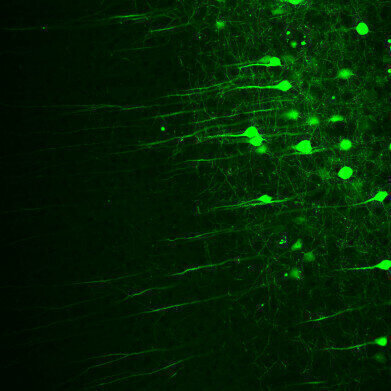-
 Two-photon imaging of GFP-labelled neurons from mouse brain.
Two-photon imaging of GFP-labelled neurons from mouse brain. -
 Toptica's laser portfolio supports neuroscience research.
Toptica's laser portfolio supports neuroscience research.
Microscopy & Microtechniques
Fibre Lasers for 2-photon Microscopy and Optogenetics
Jan 26 2022
A key technology in biological imaging in neuroscience, 2-photon fluorescence microscopy enables three-dimensional, non-invasive studies of the neuronal structure and activity on the submicron scale. The contrast mechanism in 2-photon microscopy in neuroscientific research is based on the excitation of green or red fluorescent proteins, so called GFPs and RFP, by two photons in the infrared spectral range.
To drive this nonlinear process and to resolve the neurons deep within the living brain, femtosecond lasers with clean temporal pulse shape and average output powers of >1W are an essential prerequisite.
Going beyond pure imaging, all-optical interrogation is a novel approach to understand how active patterns in neuronal activity drive behaviour. In such experiments the visualisation of neuronal activity by 2-photon imaging is combined with 2-photon optogenetics to stimulate individual neurons by photoactivation of channelrhodopsins within the cell.
With the need of exciting many neurons in parallel, the laser requirements and microscopy technology for 2-photon optogenetics are fundamentally different from 2-photon imaging. Typically, high-power multi-Watt lasers at 1030-1040nm with repetition rates in the 100kHz - 1MHz range are used in combination with a spatial light modulator (SLM) to excite 10s to 100s of neurons simultaneously.
To support and drive the research in neuroscience Toptica is proud to introduce their laser portfolio for 2-photon imaging of GFPs and RFPs, the FemtoFiber ultra 920 and FemtoFiber ultra 1050, and for 2-photon optogenetics of channelrhodopsins the FemtoFiber vario 1030 HP.
All lasers are fully matched to the requirements in neuroscientific research and besides being fully turn-key, quiet, and compact, they are offering integrated dispersion pre-compensation (GDD) and integrated power control (AOM) to simplify operation and to allow the scientist to focus on their research.
More information online
Digital Edition
Lab Asia 31.2 April 2024
April 2024
In This Edition Chromatography Articles - Approaches to troubleshooting an SPE method for the analysis of oligonucleotides (pt i) - High-precision liquid flow processes demand full fluidic c...
View all digital editions
Events
May 21 2024 Lagos, Nigeria
May 22 2024 Basel, Switzerland
Scientific Laboratory Show & Conference 2024
May 22 2024 Nottingham, UK
May 23 2024 Beijing, China
May 28 2024 Tel Aviv, Israel





.jpg)











